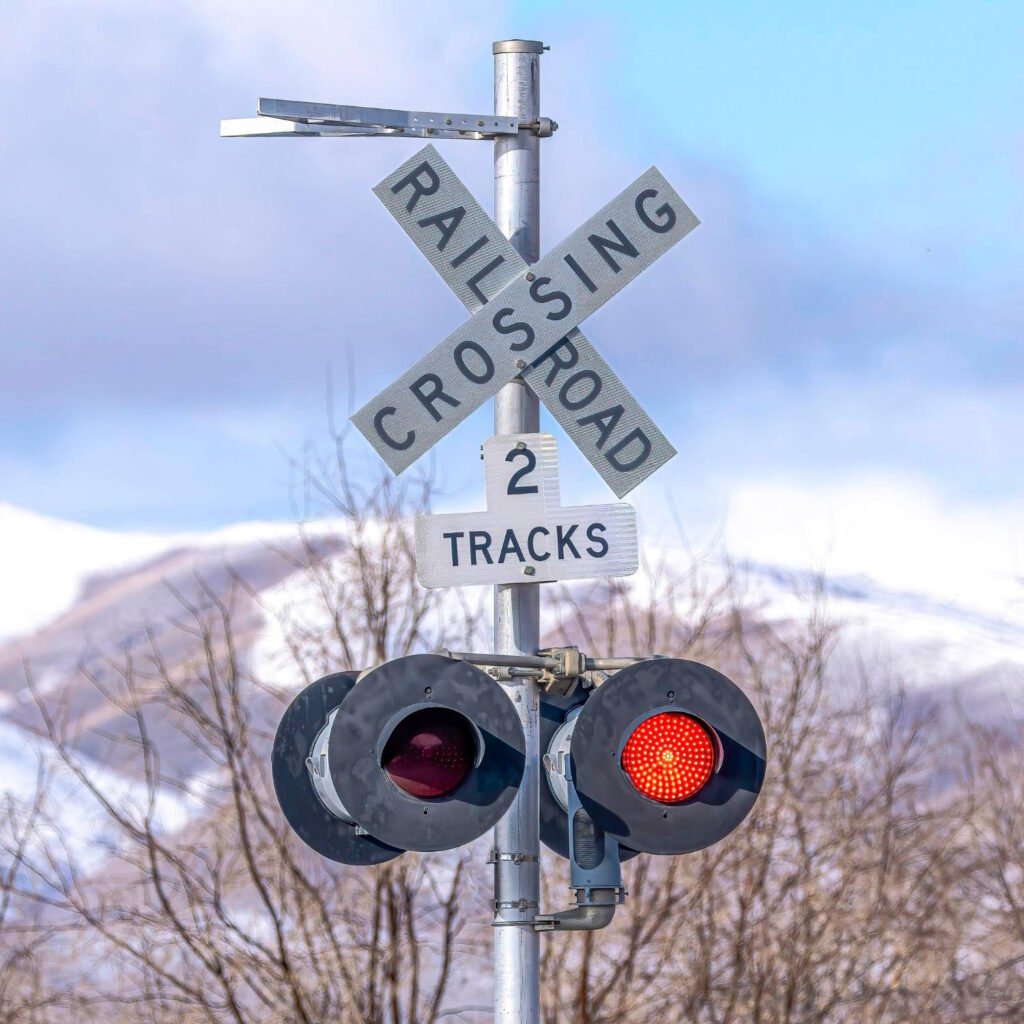Railroad crossings present unique safety challenges for drivers. Each year in the United States, there are approximately 2,000 collisions between vehicles and trains at highway-rail grade crossings. Understanding how to safely navigate railroad crossings is essential for all drivers.
Recognizing Railroad Crossings
Railroad crossings can be identified by several warning signs and devices:
Advance Warning Signs are yellow, round signs with a black “X” and the letters “RR” that alert drivers to an upcoming railroad crossing. These signs are typically placed 100 to 500 feet before the crossing.
Pavement Markings include a large “X” with “RR” on the roadway before many crossings. White stop lines may also be painted on the pavement to indicate where to stop when a train approaches.
Crossbuck Signs are white, X-shaped signs that read “RAILROAD CROSSING.” These are located at the crossing itself and are considered yield signs. A number sign under the crossbuck indicates how many sets of tracks are present.
Flashing Red Lights may be included with crossbuck signs. When these lights flash, you must stop and not proceed until the lights stop flashing and it is safe to cross. Some crossings also have gates that lower to block the roadway when a train approaches.
How to Safely Cross Railroad Tracks
When approaching a railroad crossing, slow down and be prepared to stop. Look and listen for trains in both directions. Remember that trains can come from either direction at any time.
If there are flashing lights, bells, or gates, stop at least 15 feet from the nearest rail and wait until the train passes, gates rise, and lights stop flashing before proceeding.
At passive crossings without lights or gates, look and listen for trains in both directions. If a train is approaching, stop and wait until it passes and you can see clearly in both directions before proceeding. Never try to judge the speed or distance of an approaching train.
After a train passes, wait and look for a second train before crossing. The first train might have obscured the view of another train approaching from the opposite direction.
When crossing tracks, shift to a lower gear and do not shift gears while crossing. If your vehicle stalls on the tracks, immediately get everyone out and move away from the tracks at a 45-degree angle in the direction of the oncoming train. This direction minimizes the risk of being struck by debris if the train hits your vehicle.
Special Situations and Considerations
Low-clearance vehicles such as lowboys, car carriers, moving vans, and vehicles with trailers should be especially cautious at railroad crossings. Some crossings have steep approaches or high tracks that can cause these vehicles to become stuck. Look for signs indicating low-clearance crossings.
School buses, passenger buses, and hazardous material carriers are required by law to stop at all railroad crossings, regardless of whether a train is approaching. Do not be impatient when behind these vehicles.
Certain rail operations like commuter trains can be surprisingly quiet and may not sound horns in quiet zones. Never rely solely on the sound of a train horn to warn you of an approaching train.
Wet or snow-covered tracks can be especially slippery. Approach with extra caution in adverse weather conditions.
Legal Requirements and Penalties
Never stop your vehicle on railroad tracks. If traffic is backed up on the other side of the crossing, wait until you are sure you can completely clear the crossing before proceeding.
It is illegal to drive around lowered gates. Violators face significant fines, potential license suspension, and increased liability if an accident occurs.
In most states, it is illegal to pass any vehicle within 100 feet of a railroad crossing.
Emergency Situations
If your vehicle becomes disabled on railroad tracks, immediately evacuate everyone from the vehicle and the vicinity of the tracks. Move away from the tracks at a 45-degree angle in the direction from which a train would come to avoid being struck by debris.
Look for the Emergency Notification System (ENS) sign posted at or near the crossing. This blue and white sign provides a toll-free number and crossing ID number to call for emergency assistance or to report problems.
The Physics of Train Safety
A typical freight train traveling at 55 mph takes more than a mile to stop once emergency brakes are applied. By the time an engineer sees a vehicle on the tracks, it is often too late to stop in time.
The average freight car weighs 132 tons. A locomotive can weigh up to 200 tons. The weight ratio between a train and a car is similar to the weight ratio between a car and a can of soda. The train will always win in a collision.
By following these safety guidelines, drivers can help prevent tragic accidents at railroad crossings and ensure their own safety and the safety of their passengers.



